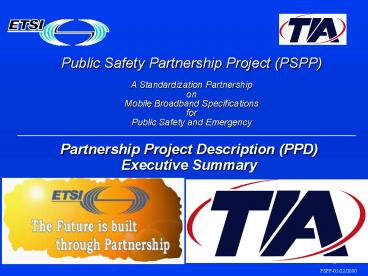Partnership Project Description PPD Executive Summary PowerPoint PPT Presentation
1 / 21
Title: Partnership Project Description PPD Executive Summary
1
Partnership Project Description (PPD)Executive
Summary
Public Safety Partnership Project (PSPP)A
Standardization PartnershiponMobile Broadband
Specifications for Public Safety and Emergency
2
Background
- Criminal activities are aided by communications
technology surpassing that currently available to
Law Enforcement - Mutual Recognition Arrangement (MRA) between the
United States of America and the European Union
(EU) in the field of telecommunications
equipment has been signed by both parties - The recent EU-Treaty of Amsterdam has raised the
pan European Police co-operation to EU level from
national level facilitating international
co-operation.
3
Background
- The US Federal Bureau of Investigation (FBI) has
been empowered by the US Government to work with
the EU on cooperation regarding Public Safety and
Law Enforcement matters - Project 34 (P34) has produced an excellent
Statement Of Requirements (SOR) regarding future
high speed data applications and services. - The P34 SOR has been reviewed by ETSI DAWS and
show a very high degree of commonality with the
European requirements
4
PARTNERSHIP
ETSI
TIA
PROJECT 34
DAWS
5
Dynamics of Worldwide Standards
A Global Process driven by User Requirements
6
Scope and objectives of the PSPP
- Mobile Broadband Specifications for Public
Safety - Supporting identified needs of very high
bit-rate type of services - Goes well beyond current standards for 3rd
Generation public mobile systems, e.g., IMT-2000 - Broadband data gt 2 Mbits/s
- Direct ATM Port Access
- Full mobility with roaming
- High level of security
- Supports Secure IP Telephony
7
One StandardThousands of Public Safety
ApplicationsMillions of UsersDeveloped in
Partnership
- One standard for Public Safety, to serve over
- 800 million citizens in North America and in
EU/EEA - New multi-media applications such as
- WEB portable terminals
- Secure IP-Internet Telephony,
- 2-way imaging and full motion video,
- IRIS Scan etc.
- Surveillance applications
- real time mobile full motion video
- real time officer safety scan
- Wireless Tele-Medicine
- Remote patient monitoring
8
Disaster ManagementRemote Patient Monitoring
Frontline Medical Assistance via Broadband
Wireless Networking Video on-line Electro
Encephalographic data (EEG) Electro Cardiograph
(ECG) Blood Pressure Temperature(internal)
High Bit-Rates Saves Lives
9
Video Surveillance
Automatic Recognition on Detection
of -Sound -Image -Movement -Material -Radiati
on
10
Mobile Robotics
- Automated inspection of non-accessible areas
- Rescue of people from hazardous areas
- Anti terrorist actions
- Incident response both tactical and non-tactical
- Urban warfare
- Fire Fighting
- Haz-Mat Handling
- Airborne control
11
Broadband Out There
- Terrestrial support in the SATCOM Scenario
- Megabit up/downlinks
- Mobile Broadband Repeater
- Remote Disasters
- Evidence gathering
- Surveillance
- Remote sensing
12
Standards Position of the PSPP
MOBILITY m/sec
Aero- nautical
Vehicle
Walk
Carrier Frequency
Fixed
Premises
Office
0.02
2
Bit Rate MBPS
0.2
20
200
Broadband
Wideband
13
PSPP Agreement Structure
International Technology Spectrum Sharing
Agreement(s) (Following US EU MRA Protocol)
NATO
CEPT/ERC
NTIA/FCC
PSPP Partnership Agreement
Founding Partners TIA/P34 ETSI/DAWS
14
PSPP
Common Requirements Specification
Common Technical Specification
- OUTPUT
- One harmonized standard for Broadband Terrestrial
Mobility - Applications and Services driven by common
scenarios and - spectrum allocations
15
Internal structure of PSPP (2)
PSPP
Steering Committee
TSG
TSG
TSG
SSG
Services and Applications
Radio Access Network
Core Network
Terminals
Technical Specifications
16
Conclusions
- All Levels of Public Safety are Interested!
- All Disciplines of Public Safety Will Benefit!
- The Opportunity Exists Today to Advance Public
Safety Communication Capabilities! - Government and Industry Cooperation Bring About
the Possibilities! - Global Cooperation - Global Markets- Global
Partners - More information at www.tiaonline.org and
www.ps2p.org
17
(No Transcript)
18
APCO Project 25/34 Materials
Key Contacts Mr. Craig M. Jorgensen, Project
Director 1398 Michigan Ave. Salt Lake City, Utah
84105 Telephone Number - 1-801-583-1099 Fax
Number - 1-801-581-9605 E-mail Address -
jorgensen_at_sisna.com Mr. John Powell, Chair,
User Needs Subcommittee - P34 P.O. Box 4342,
Berkeley, CA 94704 Telephone Number -
1-510-642-4832 Alternate Telephone Number
1-510-741-8936 Fax Number - 1-603-688-7867Alternat
e Fax Number 1-510-741-7863 E-mail Address -
jpowell_at_uclink.berkeley.edu
19
Glossary
DAWS Digital Advanced Wireless
Services ETSI European Telecommunication
Standards Institute PSPP Public Safety
Partnership Project TIA Telecommunications
Industry Association SOR Statement of
Requirements MPEG Motion Picture Experts
Group HDTV High Definition Tele
Vision TETRA Terrestrial Trunked
Radio GPRS General Packet Radio
Services BRAN Broadband Radio Access
Network UMTS Universal Mobile Telecommunication
System 3G Third Generation MRA Mutual
Recognition Arrangement CEPT Conference
Europeenne de Post et Telegrafique ERC European
Radio Committee EU European Union EEA European
Economic Area NATO North Atlantic Treaty
Organization
20
Frequencies/Spectrum
- The Specifications will allow multi-band
operation to fit the needs of different regions
and Public Safety Requirements - The frequency allocations to be applied will be
decided between the users and their relevant
regulatory authorities - Due to the very high bit-rates spectrum below 3
GHz is not technically feasible - Regional spectrum authorities have been notified
of the potential spectrum requirements
21
Additional Partners
Subject to the establishment of future Mutual
Recognition Arrangements (MRAs) additional
Organizational Partners shall be considered by
the Partners

